Facts from the history

"King and his castle".
Tomek Król the author of paintings,
here
against the
reconstruction of the castle background.In
1367 the Polish king - Kazimierz The Great gave the river basin of Wiar,
not well-settled one, to Stefan Węgrzyn of the Sas's coat of arms. There
already existed Rybotycze, Huwniki, Sierakośce and settlements next to
monasteries : Siemionów nowadays Pacław, Honoffry nowadays Posada Rybotycka
and Trójca. The first owners had the surname Rybotyccy. The town charter
to Rybotycze was given by king Kazimierz Jagiellończyk. In that new town
the Rybotycki family settled Poles. Thoughout the 15th century they carried
on an intensive settlement action, creating many new villages. Next, Rybotycze
was in the hands of Komarniccy, Drohojewscy, Stadniccy, Ossolińscy, Sobiescy.
In the 18th century it belonged to Lubomirscy, Radziwiłłowie, Brześciańscy,
and since the 19th century to Tyszkowscy, who at the beginning of the 20th
century bequeathed it to The Polish Academy Of Skills. (information taken
from: www.turczynski.pl/rybotycze.php)
There were invasions of Turks (1498), Tartars (1524; 1672) and Swedish
(1705-1707). First Jewish families probably moved here from Bircza in the 17th
century. In the twenties local Jews dominated craft and trade. They used
to live around the market square and there they had their schops and workshops.
At the beginning of the 19th century Elimelech Szapiro was the rabbi, he
was the founder of the dynasty of Dynowski cadics . The brick synagogue
and cheder were demolished during the Second World War. The village was
famous for its tanners, bricklayers, shoemakers (it was the center of 
The census of the inhabitants of Rybotycze
made on the basis of a phone
book from
1929.shoemakers util 1939). Here was situated
a paper work place and a glasswork. Also a mine of iron
ore was to be build here but the war prevented people from completing that
plan. The main farmer's markets took place on 10th and 14th December.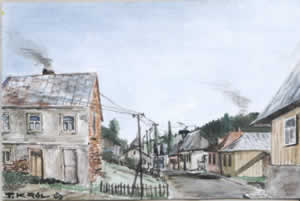
The painting made by Tomasz król. In 1910, fire destroyed most parts of the town
but they were fast rebuilt. In 1915 an epidemy of cholera decimated local
people. In 1921, there lived 774 Greek Catholics, 174 Roman Catholics and
314 Jews in Rybotycze. In this smalltown there were 228 houses. In 16th-18th
centuries it was also the centre of iconic art. Since 1836, because of
closing the chuch due to technical problems, Poles attended the holy masses
in local orthodox churches for 30 years. In 1868 the Tyszkowskis founded
a brick church which still exists. The parish has its own website www.rybotycze1.webpark.pl.
Now in Rybotycze there live only 436 people (2004 r.) and there are 95
houses. 
The old mill. The painting by Tomasza Króla

Borysławka, which does not exist any more.
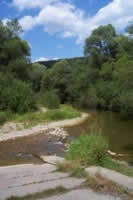
The view on the place where
there used to be Borysławka
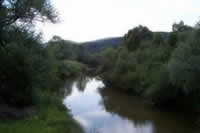 Strolling
along the stream we spotted a smiling, kind, old lady, her name was Halina
Fajfer. Her mother was an Ukrainian and father was a Pole. We have found
out that Mrs. Halina was from Borysławka, which is situated about 1 km from
Rybotycze. In that village, before the war, there lived about 150 families,
two of which were Jewish. Mrs. Halina, still can remember the names of her
Jewish friends (Riwa, Ruhla i Mendel).
Strolling
along the stream we spotted a smiling, kind, old lady, her name was Halina
Fajfer. Her mother was an Ukrainian and father was a Pole. We have found
out that Mrs. Halina was from Borysławka, which is situated about 1 km from
Rybotycze. In that village, before the war, there lived about 150 families,
two of which were Jewish. Mrs. Halina, still can remember the names of her
Jewish friends (Riwa, Ruhla i Mendel). 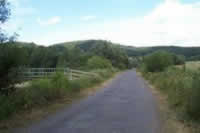 Unfortunately,
today there are no houses, neither Jewish, nor Ukrainians or Polish.
Unfortunately,
today there are no houses, neither Jewish, nor Ukrainians or Polish. At the end of this story - Poznan link - Mrs. Halina' husband came from Poznań
Guests from Israel

Mr. Mieczysław By a coincidence, we found a married couple. Ms.
Zofia is very touched when she is speaking about our project. Later she
asks about her friends from Israel.
- Where are you from? From Israel? It is wonderful, I am very pleased,
that I could meet you! I like your country very much and the inhabitants
are so kind too. Mieczysław, Zofia's husband comes to us. He brings some
photographs , and when we ask, whether we can see their house from the
inside, they agree without any doubts. We enter one room and sit down.
We ask Mieczysław about his past.

Together with Mr. Mieczysław - I was born in Rybotycze and I was
brought up here. After the II World War, I was sent by Germans to work
in the middle of the country. To Rybotycze I came back after the war had
finished.
- Do you know what happened with the local Jews here? - we ask.
- I do not know, I was not here at that time. But I have not heard about
any big executions. They must have been moved to ghettos, maybe in Przemyśl.
Or maybe they have been moved somewhere to the middle of the country. It
is really hard to guess.
Today Mrs. Mahunik has 3 children, who have their own families too.
Translations of macews
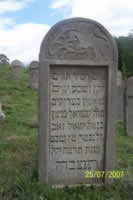
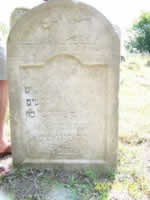
Jousef Usher was a man, who was good throughout his life and who helped people who needed his help. He died in 1932.
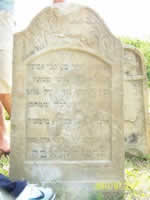
Rabi Tzwi was a young man, who was as good as his grandfather. He died in 1721.
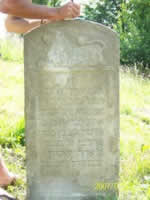
Mowa Haien Jackob, the son of Mowa Morakhai was a good, loving and obedient man who helped people and was always a good person.

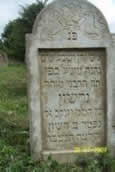
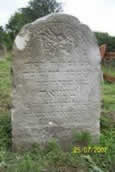
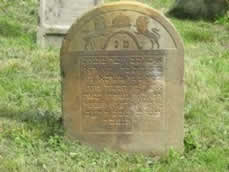
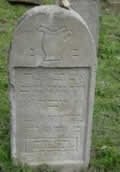

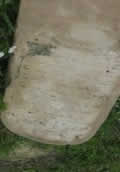
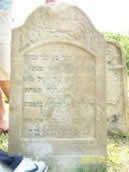
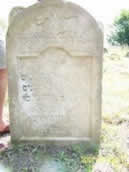
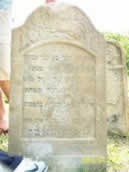
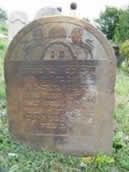


The history of the chuch in Rybotycze

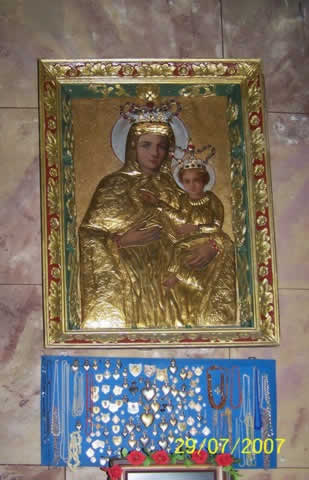
painting of famous for her grace the Virgin Mary Rybotycka.
The chuch
functionated mainly becouse of the generosity
of the inhabitants of
this parish.The history of the
chuch in Rybotycze was told to us by a young curate from that parish.
The church was built at the end of the 18th century. The inhabitants of
Rybotycze and other surrounding villages helped to build it. In the 20th century
the parish Rybotycze was very big, it consisted of few villages.
There is a painting of famous, for her grace, Virgin Mary Rybotycka. The
chuch functionated mainly because of the generosity of the inhabitants
of that parish. During the II World War it was saved by a miracle. The
inhabitants say, that there was a neighbouring storehouse of the Soviet
military weapons. When Germans declared war on Russia, in fear of the possibility
of taking over this storehouse by their enemy, Russians blew it up. In
all houses, also in the church, all windows were broken.  To
say more, under the roof, walls were cracked. But the church survived.
The only memento of those times are cracks on the ceiling. The church is
famous for the painting of the Virgin Mary Rybotycka. People know many
cases of healing because of prayers in front of this painting and the intercession
of the Virgin Mary.
To
say more, under the roof, walls were cracked. But the church survived.
The only memento of those times are cracks on the ceiling. The church is
famous for the painting of the Virgin Mary Rybotycka. People know many
cases of healing because of prayers in front of this painting and the intercession
of the Virgin Mary.
Mementos from the past

We are walking along the main road We are walking along the main road known before
as "Polish". We meet different people there. Some of them cannot tell us
anything about the past of Rybotycze, because they are only passers-by.
Some of them do not know the past of it, but kindly show us houses of the
eldery inhabitants. Everyone is very kind and wants to help us. We are
walking far away from the main road. On one side of it there are meadows.
On the other side, we can see from time to time small houses. We enter
one of them. 
In the past there lived shoemakers
in Rybotycze. a big, neat
garden, a house nice
painted. Women who live there are very kind. We sit together in the house
- My parents lived in Rybotycze. After I had got married, I went
with my husband and my moher-in-law to Dolny Śląsk. - she says - After
a few years,
when my grandchild was to be born, we wanted to return to Rybotycze. We
bought a farmer lemk's hut and we redecorated it. For many years we
have been coming here with our all family on holidays. She shows us her
house.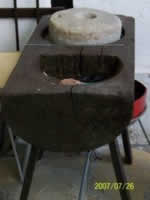
An old żarno.
- Here, in this one room 11 people lived. Next to it - she shows us the
second room - there was a stable. We redecorated it to create two different
rooms. Upstairs people used to put hay before winter. Now we have changed
it into a new room too. They show us also their "treasures". - For many
years we have been fascinated with rural things of the everyday use. We
have got an old quern+stone, hooves, which were used by shoemakers for
making shoes an old quern -stone In the past in Rybotycze there lived shoemakers
paintings that show the orthodox church in Rybotycze, which now is demolished.
While we were looking at the room the second lady brought us some photos.-
That is how this cottage used to look like, when we bought it. You can
see in what condition it used to be. Only later we made it a place which
can be used. We painted it in different colours, I made stained glass in
the windows, we planted flowers. - But it was worth it. Rybotycze is a
great village, where we can spend our holidays with pleasure. I am pleased
that our children can find out how it is to spend holidays in the country.
A native Rybotyczanka
Now we know where to go. Inhabitants told us about Ms. Stanisława Cielniak,
who is said to be a native Rybotyczanka. They said that here is somebody
who can tell us something more, that if there is somebody who can describe
us everything very well, it is she who can do it. Ms. Stanisława Cielniak
is a very vital woman. 
Mrs. Stanisława CielniakMs. Stanisława Cielniak From the very begining
she invites us to her place, gives us some cake and tea. Meanwhile she
searches some photos and of course does not stop talking- Not so long ago
I found a kind of a document in my house. When I was
a child I lived with
my parents in an old house of a headmistress of school which is situated
here, Ms. Boberska - she explains us and takes out some old pages- these
are school marks of one of the students in the year 1929/1930. While reading
it I found something interesting. I found school marks of a girl
named Rubinfeld. I was wondering if it was not a relative of
Mr. Moses Rubinfeld. I hope that I will manage to check it. We
ask about the old Rybotycze, before the war had begun.
- But what do you want to know? Our story is so long that I do not know
from what I should start. 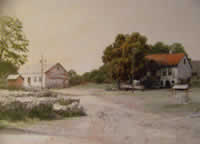 Maybe I will finish what I have started about
school. You have to know that all children attended that school, without
any exceptions. Poles, Ukrainians, Jews, to the same classes. People were
not divided according to their nationalities- Ms. Stanisława comes to us
with a big file binder.
Maybe I will finish what I have started about
school. You have to know that all children attended that school, without
any exceptions. Poles, Ukrainians, Jews, to the same classes. People were
not divided according to their nationalities- Ms. Stanisława comes to us
with a big file binder.
- Here I have got many things which surely will interest you - she shows
us old photos of Rybotycze, old documents. We ask her to tell us something
about her past- I was born in Rybotycze in 1946. - she starts - As I have
mentioned before, my family used to live in the house of Ms. Bobrowska.
During the war my mother with my grandmother were moved to Kazachstan.
Brothers of my mother fought for Monte Casino and for England.  After the
war my mother with my grandmother returned to Rybotycze. Until I was 8
I used to live here, then we moved to Szczecin. But after all these years
since we moved there I have been missing Rybotycze all the time. And then
we bought this land, we built the house and I could return here. Of course
I wanted to buy our old house, but unfortunately it was impossible. Nowadays,
my children and my grandchildren from Szczecin come here to spend their
holidays.
After the
war my mother with my grandmother returned to Rybotycze. Until I was 8
I used to live here, then we moved to Szczecin. But after all these years
since we moved there I have been missing Rybotycze all the time. And then
we bought this land, we built the house and I could return here. Of course
I wanted to buy our old house, but unfortunately it was impossible. Nowadays,
my children and my grandchildren from Szczecin come here to spend their
holidays. 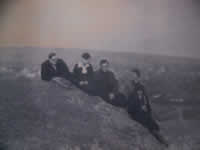
The oldest photo from 1921
- Could you tell us something about Rybotycze before the war? Ms. Stanisława
takes out a photo from her file binder.
- It is the oldest photo from 1921. When you look at it carefully, you
can see houses with thatched roofes.
the oldest photo from 1921 People used to live very modesty. Jews had their
schops, one named Kalter had even a perfume schop. It sometimes happened,
that a bishop came to Rybotycze. 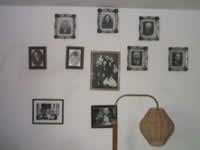 Then, on the market square, there was
an orthodox priest, a rabbi, a Polish priest and so called Banderia (a
group of 30 men on horses).
Then, on the market square, there was
an orthodox priest, a rabbi, a Polish priest and so called Banderia (a
group of 30 men on horses). 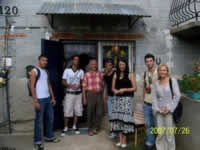 In 1921 there were 1500 inhabitants in this
place, about 700 Ukrainians, 340 Jews, the rest of people were Poles. I
will tell you how Jewish funerals looked like. The body of a dead person
was covered with linen, then women called mourners escorted it to the end
of the Polish street. Later men took it to the Jewish cemetery and buried
it. I can tell you a lot of stories about Rybotycze. We thanked Ms. Stanisławie
for her talk and showing us many interesting documents. We took school
reports from 1929 to copy them. When we were leaving the house Ms. Stanisława
added:
In 1921 there were 1500 inhabitants in this
place, about 700 Ukrainians, 340 Jews, the rest of people were Poles. I
will tell you how Jewish funerals looked like. The body of a dead person
was covered with linen, then women called mourners escorted it to the end
of the Polish street. Later men took it to the Jewish cemetery and buried
it. I can tell you a lot of stories about Rybotycze. We thanked Ms. Stanisławie
for her talk and showing us many interesting documents. We took school
reports from 1929 to copy them. When we were leaving the house Ms. Stanisława
added:
- I hope that you will manage to praise Rybotycze. It is worh it.
The stories of the inhabitants of Rybotycze Salomea Machunik and Eleonora Kurek.
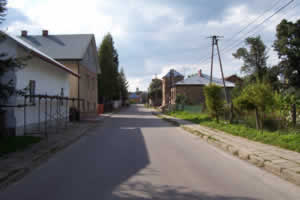
Polska street in Rybotycze
Salomea MachunikPolish St. in Rybotycze
Salomea Machunik Ms. Salomea, at the very begigning of our interview, which
took place on 26 July 2007 in Rybotycze, said that the youth before tha
war was different from the one which is now. It was full of respect for
itself and the eldery people. If somebody did something bad at school,
he got a corporal punishment from his teacher, if he complained he got
the same from his parents. One day to Rybotycze came a Jewish patriarch,
on the streets there were crowds of people welcoming him - Jews and Poles.
The patriarch was speaking in Hebrew. Although in Rybotycze lived people
of different nations, Poles called rabbi a priest and used to say to him "Praise
be to God!", and Jews used to say when meeting a Pole "Praise
be to Jesus Christ!". 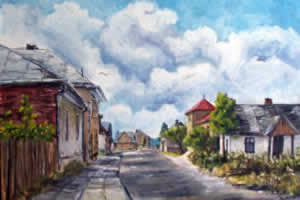
Author: Tomasz KrólPoles and Jews lived in harmony. They helped
each other, if there was such a need. Jews were hardworking, honest
and enterprising. The author Tomasz Król Their main work was trade. Young
Jewish girls used to create music associations, they were very intelligent
and friendly. This is a story from Rybotycze. One day to the Polish
bishop came a Jew who was running from Germans and asked him for a shelter.
The bishop was afraid of his own life so he refused. After long begging
he agreed. The bishop gave him a shelter, clothes and food, handled
new documents thanks to which that Jew could survive the occupation. This
is an example of Polish-Jewish solidarity during the World War II.
School

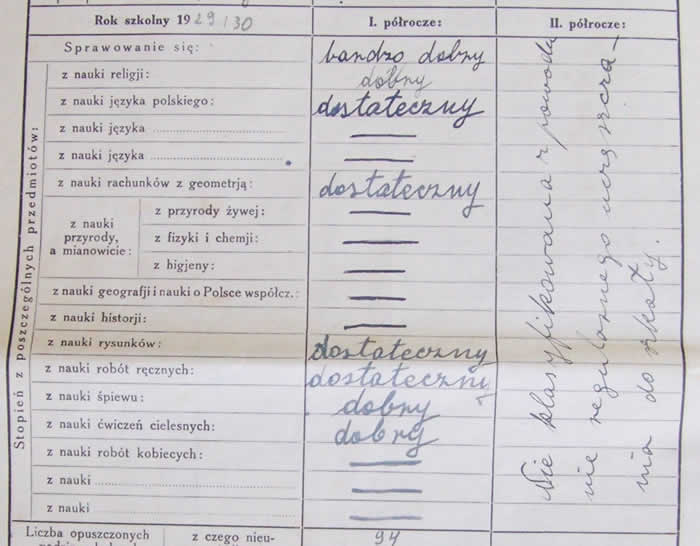
A piece of a class register 1929/1930 of a primary school in Rrybotycze,
there have surviwed 16 pages. It was made available to us by Mrs. Stanisława
Cielniak.
Gallery